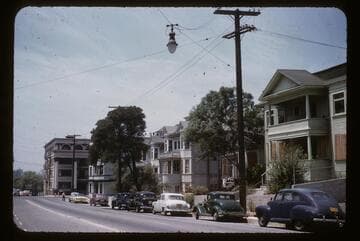Visual Materials
Angels Flight gone with the wind and Bunker Hill rebuilding
You might also be interested in

Angels Flight all gone but the track
Visual Materials
This collection consists of 35mm Kodachrome slides taken between 1954 and 1972. This collection of photographs taken by amateur photographer Palmer Conner documents by street the physical and social changes of Bunker Hill during the earliest stages of redevelopment. The collection is particularly strong in its depiction of the Bunker Hill neighborhood of downtown Los Angeles during redevelopment in the 1950s. Images chiefly consist of views of commercial and residential building exteriors taken from the street, including images of both new construction and older buildings in the process of being demolished.
photCL 486

Angels Flight from 3rd and Hill Streets
Visual Materials
This collection consists of 35mm Kodachrome slides taken between 1954 and 1972. This collection of photographs taken by amateur photographer Palmer Conner documents by street the physical and social changes of Bunker Hill during the earliest stages of redevelopment. The collection is particularly strong in its depiction of the Bunker Hill neighborhood of downtown Los Angeles during redevelopment in the 1950s. Images chiefly consist of views of commercial and residential building exteriors taken from the street, including images of both new construction and older buildings in the process of being demolished.
photCL 486

Bunker Hill
Visual Materials
This collection consists of 35mm Kodachrome slides taken between 1954 and 1972. This collection of photographs taken by amateur photographer Palmer Conner documents by street the physical and social changes of Bunker Hill during the earliest stages of redevelopment. The collection is particularly strong in its depiction of the Bunker Hill neighborhood of downtown Los Angeles during redevelopment in the 1950s. Images chiefly consist of views of commercial and residential building exteriors taken from the street, including images of both new construction and older buildings in the process of being demolished.
photCL 486

2nd and Hill Streets from Bunker Hill
Visual Materials
This collection consists of 35mm Kodachrome slides taken between 1954 and 1972. This collection of photographs taken by amateur photographer Palmer Conner documents by street the physical and social changes of Bunker Hill during the earliest stages of redevelopment. The collection is particularly strong in its depiction of the Bunker Hill neighborhood of downtown Los Angeles during redevelopment in the 1950s. Images chiefly consist of views of commercial and residential building exteriors taken from the street, including images of both new construction and older buildings in the process of being demolished.
photCL 486

Last on Bunker Hill, the Castle
Visual Materials
This collection consists of 35mm Kodachrome slides taken between 1954 and 1972. This collection of photographs taken by amateur photographer Palmer Conner documents by street the physical and social changes of Bunker Hill during the earliest stages of redevelopment. The collection is particularly strong in its depiction of the Bunker Hill neighborhood of downtown Los Angeles during redevelopment in the 1950s. Images chiefly consist of views of commercial and residential building exteriors taken from the street, including images of both new construction and older buildings in the process of being demolished.
photCL 486

Bunker Hill being wrecked
Visual Materials
This collection consists of 35mm Kodachrome slides taken between 1954 and 1972. This collection of photographs taken by amateur photographer Palmer Conner documents by street the physical and social changes of Bunker Hill during the earliest stages of redevelopment. The collection is particularly strong in its depiction of the Bunker Hill neighborhood of downtown Los Angeles during redevelopment in the 1950s. Images chiefly consist of views of commercial and residential building exteriors taken from the street, including images of both new construction and older buildings in the process of being demolished.
photCL 486